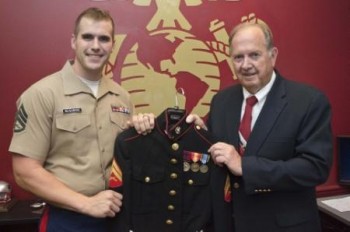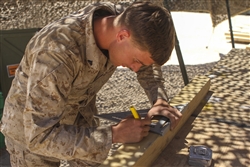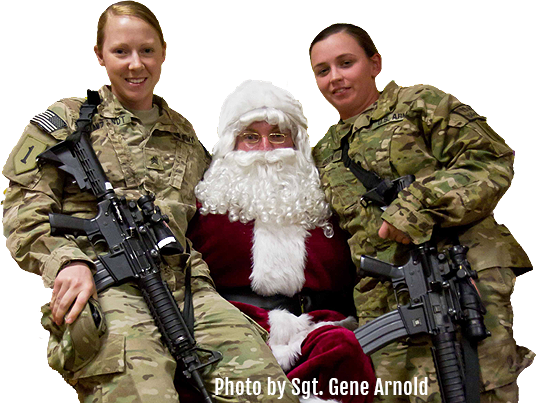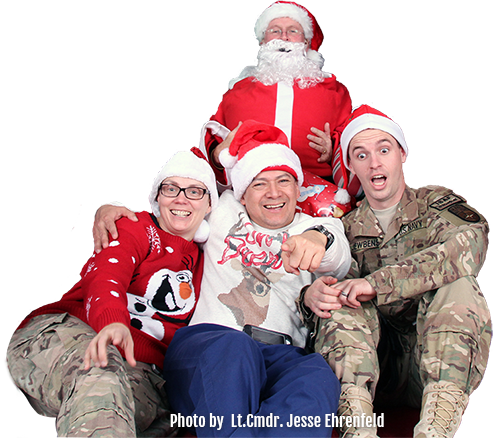 PHOTO: Marine Corps Staff Sgt. Max G. Neighbors, a canvassing recruiter with Recruiting Station Baltimore, and Robert L. Thomas and his Marine Corps dress blues jacket at Recruiting Sub-Station Salisbury, Md., July 21, 2014. U.S. Marine Corps photo by Sgt Bryan J. Nygaard SALISBURY, Md. – The Marines at Recruiting Sub-Station Salisbury here work over 60 hours every week to recruit highly qualified men and women into the Marine Corps. When they are not out canvassing the local community looking for future Marines, they are in the office making phone calls, interviewing applicants and processing paperwork. Their office frequently receives visitors who do not want to join the Marine Corps -- they just want to talk about it. These are former Marines, most of whom served before the recruiters were even born, who stop by the office to talk about their Marine Corps experiences. The recruiters will turn away from their computer screens and listen to stories about the “Old Corps.” Many of these Marine veterans even bring in books and keepsakes from their time in the service and initiate impromptu show and tell sessions in the recruiting office. Once they are finished sharing their fond memories of being one of the few and the proud, they thank the recruiters for their time, shout “OO-RAH!” or “Semper Fi!” as they leave, usually to return with a new story to share. One of these storytellers is Robert Thomas.
PHOTO: Marine Corps Staff Sgt. Max G. Neighbors, a canvassing recruiter with Recruiting Station Baltimore, and Robert L. Thomas and his Marine Corps dress blues jacket at Recruiting Sub-Station Salisbury, Md., July 21, 2014. U.S. Marine Corps photo by Sgt Bryan J. Nygaard SALISBURY, Md. – The Marines at Recruiting Sub-Station Salisbury here work over 60 hours every week to recruit highly qualified men and women into the Marine Corps. When they are not out canvassing the local community looking for future Marines, they are in the office making phone calls, interviewing applicants and processing paperwork. Their office frequently receives visitors who do not want to join the Marine Corps -- they just want to talk about it. These are former Marines, most of whom served before the recruiters were even born, who stop by the office to talk about their Marine Corps experiences. The recruiters will turn away from their computer screens and listen to stories about the “Old Corps.” Many of these Marine veterans even bring in books and keepsakes from their time in the service and initiate impromptu show and tell sessions in the recruiting office. Once they are finished sharing their fond memories of being one of the few and the proud, they thank the recruiters for their time, shout “OO-RAH!” or “Semper Fi!” as they leave, usually to return with a new story to share. One of these storytellers is Robert Thomas.Meet Your Military
- Details
- Hits: 3078
 PHOTO: Air Force Staff Sgt. Jonathan MacPherson jockeys for the ball with Zachari Tate during a cycle polo game July 31, 2014, in Anchorage, Alaska. JOINT BASE ELMENDORF-RICHARDSON, Alaska – Cycle polo? What in the world is cycle polo? That's a thing? These are questions Air Force Staff Sgt. Jonathan MacPherson, a 673rd Logistics Readiness Squadron Fuels Management Flight fuels service center controller, is accustomed to hearing. Although cycle polo has been played since the early part of the 20th century, it has recently seen a surge in popularity. U.S. Air Force photo by Staff Sgt. Wes Wright A passionate competitor in the sport, MacPherson said he is happy to explain. However, what the Hoboken, New Jersey, native sometimes leaves out is the fact he has world-class talent, as demonstrated by his recent qualification to compete in the World Hardcourt Bike Polo Championships in Montpellier, France, later this month.
PHOTO: Air Force Staff Sgt. Jonathan MacPherson jockeys for the ball with Zachari Tate during a cycle polo game July 31, 2014, in Anchorage, Alaska. JOINT BASE ELMENDORF-RICHARDSON, Alaska – Cycle polo? What in the world is cycle polo? That's a thing? These are questions Air Force Staff Sgt. Jonathan MacPherson, a 673rd Logistics Readiness Squadron Fuels Management Flight fuels service center controller, is accustomed to hearing. Although cycle polo has been played since the early part of the 20th century, it has recently seen a surge in popularity. U.S. Air Force photo by Staff Sgt. Wes Wright A passionate competitor in the sport, MacPherson said he is happy to explain. However, what the Hoboken, New Jersey, native sometimes leaves out is the fact he has world-class talent, as demonstrated by his recent qualification to compete in the World Hardcourt Bike Polo Championships in Montpellier, France, later this month.
Bike polo is played in more than 30 countries, and it grows in popularity each year. MacPherson qualified to compete in the world championship after competing in the North American Hardcourt regional qualifier in July. His team was one of the top 16 qualifiers to advance to the world championship. For some people, the word polo might conjure up images of English gentlemen on horseback wielding oversized clubs -- playing what looks to be a hybrid version of hockey and golf. That's not far off the mark, MacPherson said. However, the game of polo has evolved and taken on many forms since the late 1800s. One of the more popular iterations of the sport is known as "hardcourt," typically played on a street hockey rink.
Read more: Meet Your Military: Unusual Sport Takes Airman to France
- Details
- Hits: 3222
 PHOTO: A medical group with the Danish Home Guard practices wound analysis, preparation and movement of a casualty to an aid station in Denmark, June 20, 2014. U.S. Army photo by 1st Lt. Kyle KennedySALT LAKE CITY – Through the Military Reserve Exchange Program, a computer operations officer with U.S. Strategic Command’s Army Reserve Element trained with the Danish Home Guard in Denmark. Exercises with American soldiers participating through the Military Reserve Exchange Program provide all involved with a joint training environment. “The entire trip was fun,” said Army 1st Lt. Kyle Kennedy, a Columbus, Nebraska, native. “The Home Guard liaisons made sure our days were packed from 7 a.m. to 10 p.m., and they went above and beyond to make sure we got to see the whole country and experience the Danish Home Guard way of life.” While working in Demark June 11-25, Kennedy learned how the Danish Home Guard runs its logistics, medical and armor operations, its shooting competitions, and its day-to-day activities.
PHOTO: A medical group with the Danish Home Guard practices wound analysis, preparation and movement of a casualty to an aid station in Denmark, June 20, 2014. U.S. Army photo by 1st Lt. Kyle KennedySALT LAKE CITY – Through the Military Reserve Exchange Program, a computer operations officer with U.S. Strategic Command’s Army Reserve Element trained with the Danish Home Guard in Denmark. Exercises with American soldiers participating through the Military Reserve Exchange Program provide all involved with a joint training environment. “The entire trip was fun,” said Army 1st Lt. Kyle Kennedy, a Columbus, Nebraska, native. “The Home Guard liaisons made sure our days were packed from 7 a.m. to 10 p.m., and they went above and beyond to make sure we got to see the whole country and experience the Danish Home Guard way of life.” While working in Demark June 11-25, Kennedy learned how the Danish Home Guard runs its logistics, medical and armor operations, its shooting competitions, and its day-to-day activities.
Military Reserve Exchange Program provides reserve-component officers with training associated with mobilization duties while enhancing their ability to work and communicate with service members of the host nation. “He is a unit role model and leader with impeccable character,” said Army Lt. Col. Mike Poss, commander of Stratcom’s Army Reserve Element.
Read more: Meet Your Military: Reserve Soldier Trains With Danish Home Guard
- Details
- Hits: 3641
 PHOTO: Marine Corps Staff Sgt. Max G. Neighbors, a canvassing recruiter with Recruiting Station Baltimore, and Robert L. Thomas and his Marine Corps dress blues jacket at Recruiting Sub-Station Salisbury, Md., July 21, 2014. U.S. Marine Corps photo by Sgt Bryan J. Nygaard SALISBURY, Md. – The Marines at Recruiting Sub-Station Salisbury here work over 60 hours every week to recruit highly qualified men and women into the Marine Corps. When they are not out canvassing the local community looking for future Marines, they are in the office making phone calls, interviewing applicants and processing paperwork. Their office frequently receives visitors who do not want to join the Marine Corps -- they just want to talk about it. These are former Marines, most of whom served before the recruiters were even born, who stop by the office to talk about their Marine Corps experiences. The recruiters will turn away from their computer screens and listen to stories about the “Old Corps.” Many of these Marine veterans even bring in books and keepsakes from their time in the service and initiate impromptu show and tell sessions in the recruiting office. Once they are finished sharing their fond memories of being one of the few and the proud, they thank the recruiters for their time, shout “OO-RAH!” or “Semper Fi!” as they leave, usually to return with a new story to share. One of these storytellers is Robert Thomas.
PHOTO: Marine Corps Staff Sgt. Max G. Neighbors, a canvassing recruiter with Recruiting Station Baltimore, and Robert L. Thomas and his Marine Corps dress blues jacket at Recruiting Sub-Station Salisbury, Md., July 21, 2014. U.S. Marine Corps photo by Sgt Bryan J. Nygaard SALISBURY, Md. – The Marines at Recruiting Sub-Station Salisbury here work over 60 hours every week to recruit highly qualified men and women into the Marine Corps. When they are not out canvassing the local community looking for future Marines, they are in the office making phone calls, interviewing applicants and processing paperwork. Their office frequently receives visitors who do not want to join the Marine Corps -- they just want to talk about it. These are former Marines, most of whom served before the recruiters were even born, who stop by the office to talk about their Marine Corps experiences. The recruiters will turn away from their computer screens and listen to stories about the “Old Corps.” Many of these Marine veterans even bring in books and keepsakes from their time in the service and initiate impromptu show and tell sessions in the recruiting office. Once they are finished sharing their fond memories of being one of the few and the proud, they thank the recruiters for their time, shout “OO-RAH!” or “Semper Fi!” as they leave, usually to return with a new story to share. One of these storytellers is Robert Thomas.Read more: Meet Your Military: Marine Corps Vet Recalls Experiences
- Details
- Hits: 3072
 PHOTO: Marine Corps Cpl. Tanner Lechner measures wood for a “gear tree” during Large Scale Exercise 2014 at Marine Corps Air Ground Combat Center Twentynine Palms, Calif., Aug. 4, 2014. MARINE CORPS AIR GROUND COMBAT CENTER TWENTYNINE PALMS, Calif., Aug. 11, 2014 – On an uncomfortably hot day in the Mojave Desert, many service members participating in Large Scale Exercise 2014 were preparing for the day to end.A gear tree is for storing body armor and a helmet. The bilateral training is building U.S. and Canadian forces’ joint capabilities. U.S. Marine Corps photo by Lance Cpl. Angel Serna But one Marine decided it was the perfect weather to bring out his tools and some spare wood to create something from scraps of nothing. Cpl. Tanner Lechner, a combat engineer with Combat Service Support Company, 1st Brigade Headquarters Group, 1st Marine Expeditionary Brigade, said he enjoys his time out in the field regardless of the weather, because he gets to practice and improve his construction and creativity skills. Before he joined the Marine Corps, Lechner lived in Topeka, Kansas, up to his early adulthood. After high school, he said, he wanted to take charge of his life and do something he enjoys.
PHOTO: Marine Corps Cpl. Tanner Lechner measures wood for a “gear tree” during Large Scale Exercise 2014 at Marine Corps Air Ground Combat Center Twentynine Palms, Calif., Aug. 4, 2014. MARINE CORPS AIR GROUND COMBAT CENTER TWENTYNINE PALMS, Calif., Aug. 11, 2014 – On an uncomfortably hot day in the Mojave Desert, many service members participating in Large Scale Exercise 2014 were preparing for the day to end.A gear tree is for storing body armor and a helmet. The bilateral training is building U.S. and Canadian forces’ joint capabilities. U.S. Marine Corps photo by Lance Cpl. Angel Serna But one Marine decided it was the perfect weather to bring out his tools and some spare wood to create something from scraps of nothing. Cpl. Tanner Lechner, a combat engineer with Combat Service Support Company, 1st Brigade Headquarters Group, 1st Marine Expeditionary Brigade, said he enjoys his time out in the field regardless of the weather, because he gets to practice and improve his construction and creativity skills. Before he joined the Marine Corps, Lechner lived in Topeka, Kansas, up to his early adulthood. After high school, he said, he wanted to take charge of his life and do something he enjoys.
His life-changing decision was inspired by his grandfather, who retired as a captain from the Marine Corps, Lechner said. His grandfather’s stories of his career motivated him to the point that he decided to join the Marine Corps in 2011, he added. “I picked combat engineer as my [specialty] when I joined,” the 21-year-old Marine said. “It wasn’t my first choice, but I couldn’t do reconnaissance, because I was color blind. My recruiter mentioned to me, ‘As a combat engineer, you’ll get to build things and blow stuff up,’ so I said, ‘Yeah! Put me there.’” After graduating from recruit training and his specialty school, Lechner said, he moved on to the operational forces, which gave him the opportunity to deploy and conduct his job. “We made what [we] would call a ‘triple-nickel 40’ out of cratering charges on a partially dry lake bed in the Philippines,” he said. “When this thing went off, it made this massive crater, and all of the water that was underground came rushing in. It instantly filled with water, and we were like, ‘Hey, we made a big pond.’”
Read more: Meet Your Military: Combat Engineer Practices Skills in Exercise
- Details
- Hits: 3166
 PHOTO: Senior Airman Christopher Moore has been a mechanic for the Air Force for three years and is deployed to Southwest Asia from the 86th Vehicle Readiness Squadron, Ramstein Air Base, Germany, in support of Operation Enduring Freedom. U.S. Air Force photo by Staff Sgt. Jeremy Bowcock SOUTHWEST ASIA – What little boy doesn't like ripping apart his toys and making a mess of things? But the older most men get, the more expensive and fancier the toys become. Air Force Senior Airman Christopher Moore, a vehicle mechanic with the 386th Expeditionary Logistics Readiness Squadron, is no exception. When it comes to tinkering and fixing things, he has a passion and curiosity for it all. Now, his toys are much bigger than they were when he was a boy, and they belong to the Air Force. "Working on cars brings a sense of pride when you see what you've fixed," Moore said. "I recently replaced the engine in a truck. It took three days to take apart the entire vehicle, but it felt good to hear the engine fire up and to watch it drive away." He said he likes to challenge himself and feels confident in his skills to try new projects and learn from them.
PHOTO: Senior Airman Christopher Moore has been a mechanic for the Air Force for three years and is deployed to Southwest Asia from the 86th Vehicle Readiness Squadron, Ramstein Air Base, Germany, in support of Operation Enduring Freedom. U.S. Air Force photo by Staff Sgt. Jeremy Bowcock SOUTHWEST ASIA – What little boy doesn't like ripping apart his toys and making a mess of things? But the older most men get, the more expensive and fancier the toys become. Air Force Senior Airman Christopher Moore, a vehicle mechanic with the 386th Expeditionary Logistics Readiness Squadron, is no exception. When it comes to tinkering and fixing things, he has a passion and curiosity for it all. Now, his toys are much bigger than they were when he was a boy, and they belong to the Air Force. "Working on cars brings a sense of pride when you see what you've fixed," Moore said. "I recently replaced the engine in a truck. It took three days to take apart the entire vehicle, but it felt good to hear the engine fire up and to watch it drive away." He said he likes to challenge himself and feels confident in his skills to try new projects and learn from them.
Moore grew up in Lebanon, Missouri, with his father after his parents divorced. He was 13, when he started working as a floor sweeper at a salvage yard. Throughout his teenage years, he spent his time working at his father's vehicle restoration shop, where he developed his skill for working on cars. In college, he worked as a mechanic at a major automotive business and continued to refine his maintenance skills. "I went to college for two years, taking classes such as marine biology, science and other subjects, but I was really drawn to auto mechanics," said Moore, who is deployed from Ramstein Air Base, Germany.
Read more: Meet Your Military: Vehicle Mechanic Brings Passion to His Service






